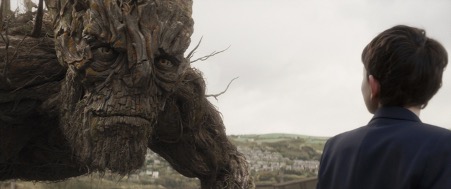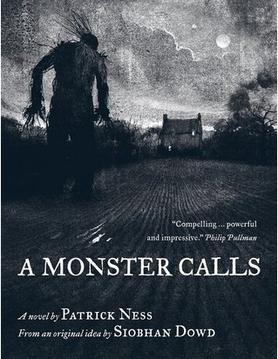
‘Stories are wild creatures…when you let them loose, who knows what havoc they might wreak?’
(Patrick Ness, A Monster Calls, p.61)
For me, there are many connections between literature and therapy and I often find myself thinking about stories through a therapeutic lens. This occasional blog sketches out some of these reflections.
...
Stories are at the heart of everything. In Jeanette Winterson’s words, literature ‘isn't a hiding place. It is a finding place’ (Winterson 2012: 40).
Stories take many forms. They might be half remembered fairy tales, recent novels, pictures, songs, films and tv box sets. They are all ‘finding places’.
There are also the stories we tell ourselves about ourselves. The repetitions which are so familiar we can’t see them; the internal structures which, like fortified castles, both defend and imprison us.
And then there are the stories we can’t bear to tell. Old and ossified; sedimented secrets. The unspoken and unspeakable.
These stories are like knots. They are tangled and lumpy. The more we pull at the threads, the more they tighten. Therapy helps us to begin the painful process of unknotting. Alongside a therapist, we tease out the strands and, together, we see what new stories might emerge.
The relationship between client and therapist is central to the process of untangling and healing. But who is the therapist? And why would you trust them with your stories?
Within the complex psychodynamics of a therapeutic relationship, the therapist, becomes, in a sense, whatever the client projects on to them. They are, amongst other things, parent, ally, confessor, companion, healer…story seeker and story keeper.
Recently, I’ve been thinking that the therapist might also be a monster.
This might seem strange. We all know that monsters are scary, and to be avoided, so why would we willingly meet with them and ask them for help?
Is Your Therapist a Monster?
Some years ago, a client told me they had watched the film, A Monster Calls (Bayona: 2016). It had touched a deep grief. Following that session, I read the book by Patrick Ness (Ness: 2011) and, just recently, I also watched the film. The book was originally conceived by the author Siobhan Dowd. Sadly, Siobhan Dowd died aged 47, before she was able to write the book, and Patrick Ness took it on. So, from the outset, this is a story layered with losses.

The story explores death, time and painful truths. It focuses on Conor, a thirteen-year-old boy whose mother is terminally ill. It opens at 12.07, exactly, when Conor wakes from a recurrent nightmare; a nightmare in which something happens that is so painful he has decided ‘no one else ever needed to know’ (12).
Someone, something, is calling his name and Conor watches as an ancient church yew tree transforms into a giant humanoid figure. Step by step, the atavistic monster approaches. When boy and monster face each other through Conor’s bedroom window, the monster realises that Conor isn’t frightened. Somehow, ‘this wasn’t the monster he was expecting’ (18). The monster says:
You really aren’t afraid, are you?
“No,” Conor said. “Not of you, anyway.” (19)
The next time they meet, at 12.07, Conor is waiting.
Open up, the monster said, its voice as clear as if the window wasn’t between them. I want to talk to you.
“Yeah sure,” Conor said, keeping his voice low. “Because that’s what monsters always want. To talk.” (39)
It’s a scratchy encounter. There is resistance. A push and a pull. And yet…strained and hard as it is, there is, of course, talking. And, as it goes on, the meetings between boy and monster develop a rhythm. A tempo. A call and a response. A relationship.
As the narrative unfolds, Conor watches clocks, anticipating 12.07. When the monster returns for the second time, he asks, ‘“What do you want from me?”. The Monster replies: It is not what I want from you…it is what you want from me.” (40). Conor doesn’t understand what the monster means, but he voices a question that arguably underlies any therapeutic relationship. ‘What are you?’ he asks. The monster answers:
I am not a “what”, frowned the monster. I am a “who”.
“Who are you, then? Conor said. (41)
Sometimes clients feel that this, ‘who are you?’ question can never fully be answered. We don’t generally know much about our therapist’s life and this can feel confusing and unequal, especially when we share so much of ourselves. But the therapeutic relationship is unusual. It is a strange and intimate way of meeting. In some ways, like Conor, we know nothing and everything about our therapists. This is what makes therapy special.
Without understanding exactly why or how, Conor has called the monster to him and, in a series of encounters, the monster tells Conor three perplexing and morally ambiguous tales. He says that the fourth tale will be Conor’s own truth, explaining, that ‘you know that your truth, the one that you hide…is the thing you are most afraid of’ (46).
The monster’s role is to help Conor speak this unbearable truth. The process is painful and messy.
In a pivotal scene, Conor is staying at his grandmother’s house. He experiences a rejection by his charming but careless father. Hurt and lost, he lashes out and breaks his grandmother’s expensive clock, stopping the hands, perhaps inevitably, at 12.07. The monster is called.
The monster tells Conor a twisted tale of injustice, rage and vengeance. In the telling, he invites Conor to inhabit the fury of the story and, together, they smash and crush and crunch everything in the room.
‘TEAR THE WHOLE THING DOWN!’ he roars….He was yelling as he did it, so loud he couldn’t hear himself think, disappearing into the frenzy of destruction, just mindlessly smashing and smashing and smashing. (121)
Whilst the violence of Conor’s rage is scary, it is also important. The monster knows this.
Symbolically, the monster has provided a therapeutic space. He has allowed Conor to release his repressed rage and to begin a process in which he can unlock, and face, his most deeply hidden feelings. The wrecked room thus externalises Conor’s devastated internal world. Therapeutically, it is a powerful communication.
From the outside, therapy, with its many orientations and theoretical approaches, can sometimes feel complicated and hard to navigate. There are of course meaningful differences between, say, a school counsellor and a Jungian psychotherapist, a Gestalt therapist and Kleinian analyst; but, the essence of a therapeutic encounter, is often similar. In therapy, the boundaries around time, money, space and so on, are firmly drawn. And, within these parameters, almost anything can happen. Alongside a containing and compassionate therapist, whatever their modality, clients can share their darkest fears, their most violent fantasies….and their unspeakable sorrows.
So, for me, both the book and film of A Monster Calls express some intensely moving aspects of the therapeutic process. In my reading, the monster is a kind of therapist who, in regular and contained sessions, allows the truth, however tender, raw and shameful, to be spoken. He reminds me of a psychotherapist I once knew. Like the monster, this older therapist seemed grizzled and gnarly. He asked hard questions. He seemed unknowable. Over time, I came to realise that he had a tender and loving therapeutic heart.
Conor’s truth, the fourth tale, is his recurring nightmare. ‘It’s only a dream’, he tells the monster’ (40), but the monster knows that the dream occupies the liminal space between the inner and outer self, the conscious and unconscious world, the repressed and its return. ‘But what is a dream?’ he asks. ‘Who is to say that it is not everything else that is the dream?’ (40).
In his nightmare, Conor is on a cliff edge holding on to his mum. She slips from grasp and he wakes. In the climatic closing pages of the narrative, as the scene is re-enacted, the monster urges him to express his unbearable truth. He knows that until Conor can release his walled off guilt, he will be stuck. ‘Speak the truth’, he insists, ‘or stay here forever (195).’
Conor’s unbearable truth is that he let his mother go. He has reached the core of his trauma. ‘I just want it to be finished!’ (199) he admits.
The truth, his truth, is that he is torn between wanting his mother to live and needing her to die. His ambivalence has been expressed and the monster, who although he cannot erase the boy’s suffering, allows the unspeakable to be spoken. He understands that ‘Humans are complicated beasts’:
Your mind will contradict itself a hundred times each day. You wanted her to go at the same time you were desperate for me to save her. Your mind will believe comforting lies while also knowing the painful truths that makes those lies necessary. And your mind will punish you for believing both.’ (201)
The healing begins. Once Conor has been able to tell his own story, he faces the moment of his mother’s death, at 12.07, with the monster by his side. He knows, ‘It would be terrible’,
It would be beyond terrible.
But he’d survive.
And it was for this that the monster came…Just for this moment. (214)
So, is your therapist a monster? Perhaps it’s worth remembering that the word monster derives from the Latin, monstrum, meaning ‘to demonstrate’. And this is what therapists do. They encourage and support their clients in demonstrating; looking into themselves, telling their stories, however difficult and contradictory. In other words, the monster/therapist helps us to understand and begin to accept the complexities of being human.
References
- Bayona, J A (2016) A Monster Calls
- Ness, P (2012) A Monster Calls London: Walker Books
- Winterson, J (2012) Why Be Happy When You Could Be Normal? London: Vintage
RG March 2021